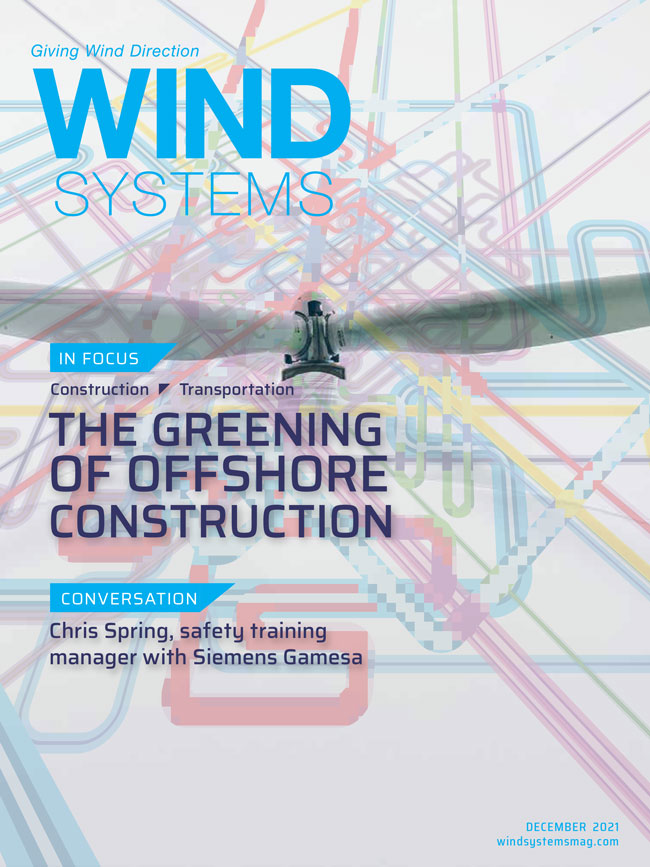Wind Academy, a wind-energy technician training program operated by Siemens Gamesa, recently announced a new initiative designed to help more aspiring wind-turbine technicians to excel in careers in the fast-growing industry of renewable wind energy, which supports 116,800 jobs throughout the United States. Chris Spring, safety training manager with Siemens Gamesa, recently talked with Wind Systems about the new program and what it can mean for aspiring wind techs.
What is your role with Siemens Gamesa Renewable Energy?
I wear two hats. I’m the safety training manager for Siemens Gamesa, where all the safety training for our North America operations takes place. I have a group of instructors that carry that out.
The other hat that I wear is that I’m the admissions manager for Wind Academy. I help get all the paperwork in order for us to be licensed by the state, I’m the initial contact for a majority of the students, and I teach several of the classes.
Tell us about your partnership with Meritize and what it means for aspiring wind-turbine technicians.
It’s actually a fantastic partnership that we have. One of the things that is unique about Wind Academy is the timeframe that we take to train our students. It’s a three-week training program, and it is almost identical to our internal training program that we have for our own technicians within Siemens Gamesa.
If you look at other major OEMs, their training programs are anywhere from two to four weeks, but if you look at a lot of the competition for wind-technician training programs out there, they’re usually six months plus. And the reason for that is because, in order to qualify for Pell grants, Stafford loans, and financial student aid, you have to be over so many credit hours, which is six months. We didn’t feel that served the students justice because we know what we need in a basic technician. We’ve done it for 20-plus years. We’re pretty successful at it.
We felt that a three-week training program, similar to what we do, would be most beneficial. But the problem is that it removes us from a lot of financial aid capability for a lot of the students. That’s definitely where a partnership with Meritize comes in. What’s fantastic about it is it allows a company to come in and provide financial aid that takes the time to not only learn their students, they don’t just look at a credit score.
Meritize came in and looked at our curriculum and realized that there’s merit and opportunity there. This was not only for the students but obviously for them too, because they’re a business as well. So, it works out well for all parties to be able to provide that financial support and to have such a short turnaround. We have an aggressive job placement service, I’m averaging from a week to two weeks after graduation, someone’s gotten an offer letter in hand. They’re on their way to a new career in maybe about a month, month-and-a-half.
This program uses a unique financial option, and you’ve touched on it a little bit, but how does this option differ from other established methods among wind-training facilities?
All other wind-training facilities are tied to community colleges. We are the only wind-training center or school that is run by an OEM. They have the traditional semester-based systems and financial-aid systems, including GI bill, Stafford or Pell grants, which help students afford training. Meritize opened up a unique opportunity for us because we didn’t have a lot of financing options available–this partnership helps students afford our training.
What other ways can the program fast track a trainee’s path to a full-fledged career?
The beautiful part about the program is it’s designed to take someone straight off the street with no real previous experience, and give them the tools to become entry-level, basic technicians in the field. Now, they’re going to spend some time OJT to learn their specific turbines, wherever site they work at, but this makes sure they know enough information to be uptower and be safe, first and foremost, and then to have enough knowledge to start the OJT learning experience for them. It definitely helps fast track students because, if you look at other schools, they teach very similar things to what we do as far as the safety training and the technical side. Because they have several months of class time, they teach very specific nuts, bolts, and maintenance procedures on that particular model of turbine that they have in their facility. That’s great, but they’ll probably never see that turbine again for the rest of their career. Even within Siemens Gamesa, we make dozens of different models of turbines. In my facility, I have two full-size nacelles, but I don’t teach the detailed maintenance on either of those two because technicians may never spend their time on it.
So why teach students a bunch of detailed information that is not going to be useful? Instead, we teach basic core information as far as how general items operate, and then they’ll get those fine details at sites. That way, it really allows them to fast track and get out in the field that much quicker.
Is there any difference between the on-the-job training with this program as opposed to a more established one?
It is still established as far as OJT, so it’s not like somebody is just coming in and being a straight apprentice, they’re getting the training completely there. There is still some amount of training that has to be done. It’s very similar to a pilot’s license: You can go out and get your commercial pilot’s license, but most airlines then want you to have so many hours before you can start being certified to transport people. You have to get out there and just get the time. This is very similar to having to have a certain amount of certifications to get into the industry and be able to climb, but then after that, it takes some time and education to be able to lead a team.
Usually the way wind turbines work is you have a team of two. You have your No. 2 person as your under-instruction tech, and that’s where your Wind Academy grad fits in. They are there to learn. They can do certain things under supervision. They can’t do LOTO (lockout/tagout) or electrically isolating the tower for work. That’s all the No. 1 person, and the No. 1 person is in charge of that team. They’re the ones who are authorized to do the maintenance items and everything else, and they’re the instructor, so that’s where the OJT aspect comes in. That’s how the wind industry’s been working for quite some time. And again, that’s where Wind Academy techs plug in, is with that No. 2. And they’ll be in that position six months to two years before they get additional training/qualifications and then jump to that team lead.
How does wind technology offer high-growth career pathways?
Wind Academy starts our learners on a career path. Graduates will be in that position as that No. 2 person assisting for six months to two years, then they’ll move up to what you call a maintenance tech. They’re responsible for all preventative maintenance and some corrective maintenance. They’ll be in that position for three to five years. After some additional training, they’ll come out as what we call a troubleshooter; other companies have similar terms. But these are the senior level guys and girls who, if the tower’s broken and we don’t have a clue why, we send them in, and they figure it out, and they write the procedure on how to fix it the next time. You start out on average $45,000 to $50,000 a year as an entry-level, basic technician. As the maintenance tech, you’re making $60,000 to $70,000, and the troubleshooters are sometimes making over six figures.
In a seven-year span, they can then become a site lead. Now, they’re the senior-level technicians, so that’s a bump as well. They could be the site manager if they want to jump over to a salary position. Now, they’re organizing the maintenance schedules, working with the customers, responsible for output, you name it. They can jump from there to a regional manager or district manager for multiple wind farms. We have many individuals, all up and down our leadership and management structure, that were prior techs, 10, 15, 20 years ago. Now, they’re in charge of our HSE program, or they’re in charge of our training program, so it’s definitely a career path. It’s not that you get hired in and that’s it for the next 40 years; it’s not the only position you do.
What kind of other opportunities are available?
There are a lot of different branches, learners aren’t tied to a single wind farm. There are both static jobs and traveling technicians. If you like to be out and about a little bit more, you can go from a cow pasture to a wind farm in six-months’ time, building out a site. There are also offshore wind opportunities that are definitely growing across the United States.
If those individuals like a little more adventure, they can learn some fiberglass repair, and they’ll be hanging from a rope 300 feet in the air grinding and doing fiberglass layup on a blade still attached to the turbine.
You can be a drone pilot and do external inspections of turbine towers. There are definitely different branches, so if you get into one, and you don’t necessarily like the flavor, you can make jumps pretty easily within the industry.
When will the new program be made available to potential applicants, if it’s not already, and what’s involved in becoming a trainee?
We’ve been certified or licensed by the State of Florida since September of last year. And our first class was March 2021 and we’ve been holding classes monthly. We usually start them the first week of the month. Right now, we’re holding one class; and probably next year I’m going to have enough student load that I’m going to be running two classes simultaneously. The class is limited to six students, so it’s a great low number for student-to-instructor ratio, so there’s a lot of engagement, a lot of hands-on activities. We’ve got a full class going through now. We’ve got another full class going through in December. And then, like I said, January is probably when we’ll start kicking off a second class simultaneously.
Students go to our website and start the application process. It’s not a terribly high bar for requirements: 18 years or older, high-school diploma or a GED, and they must be able to read, write, and speak English, because our curriculum is in English. And then, this one’s kind of a softer requirement, but you have to be under 265 pounds. You can still partake in most of the classes, but you can’t do the climb safety stuff and other items because the harnesses and the safety gear are only rated to a certain weight. And we want to make sure that if, should you need it, that it works and catches you, should they take a fall.
Do you see this as an opportunity for other people who might be looking for a different career path?
Definitely. I’ve had students from all over the place. I had a beekeeper. I had an elementary teacher who was in his 40s. I’ve got two kids in class right now, one who was a landscaper, another guy who was a security guard, and they’re both 21 years old, so they’re doing a brand-new start of their career. But, for somebody who’s like, “Hey, I want to do something different and work outside,” I’ve got one guy in class right now, he’s in his mid-40s; he was a musician for a good 20 years in a cover band, and now he’s looking to do something a little different.
It’s definitely a great way to jump into an industry that is the fastest growing industry in the country right now. It lets you be able to get out there really fast. Trying to get your bachelor’s degree after you’ve been working for a while, it’s challenging when you have a family. So, to be able to come in, knock it out in three weeks, and then be back out doing something, that’s beneficial to a lot of people who are trying to reinvent themselves.
Is there anything else you’d like to mention?
The Wind Academy program has two primary purposes: First, we know the industry, and it needs a pipeline because there’s not a lot of schools offering a true technician training, if you will, and even fewer that offer ones with internationally recognized credentials attached to it. We definitely want to get more technicians out in the field because we see how much wind power is going to explode here in the United States, but then it also helps us because then there are more technicians to hire. But first and foremost, we want to try and be good stewards of the industry.
More info www.windacademyusa.com































